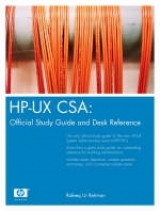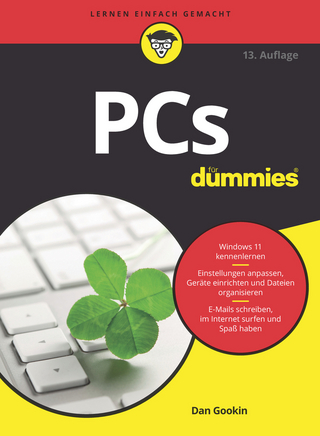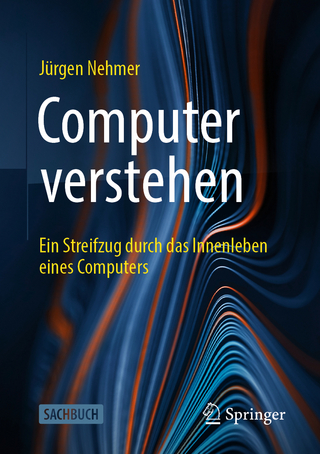
HP Certified
Prentice Hall (Verlag)
978-0-13-018374-3 (ISBN)
- Titel erscheint in neuer Auflage
- Artikel merken
PLEASE PROVIDE
More and more companies are either requiring HP-UX certification or offering financial incentives to those who achieve it. This is the only all-in-one, authorized reference for HP-UX certification. It covers every exam objective in HP's four-part HP-UX System and Network Administration exam (3HO-001). It's designed not only to help sys admins prepare for the exam, but to remain an invaluable resource once they're certified. The book's coverage maps precisely to HP's exam objectives. It starts with the fundamentals of UNIX systems: logins, general shell concepts, file management, environment variables, I/O, vi editing, regular expressions, filesystems, and the POSIX shell. Next, it reviews the fundamentals of HP-UX system administration, from installation and system startup to building kernels, patch management, peripherals, the HP-UX file system, user/group management, processes, printing, memory management, backup, job automation, security, auditing, performance monitoring, and more. In Section 3, the book covers every key skill related to HP-UX networking, from configuring LAN devices and IP connectivity, to NFS, DNS, NIS, diskless workstations, and more.
The book contains hundreds of review questions -- plus a complete sample exam.
RAFEEQ UR REHMAN is an HP Certified System Administrator, MCSE, and CCNA. He has over eight years of experience in UNIX system administration and four years with Windows NT. He is also an experienced C and database programmer.
I. FUNDAMENTALS OF THE UNIX SYSTEM.
1. Getting Started with UNIX.
UNIX Shells. Logging In and Out of HP-UX. The Superuser. Logging In. Shell Prompts. Logging Out. Home Directory. Using HP-UX Commands. Extrinsic and Intrinsic Commands. Changing Your Password. Shell History and Repeating Commands. Command Aliases. Shell Startup Files. System Startup File. User Startup File. Some Simple HP-UX Commands. Where Am I? What Is the Current Date and Time? Who Are Others and Who Am I? What Is the Name of My System? Printing Banners. The Calendar. Getting Help with Manual Pages. Executing Multiple Commands on One Line. Options and Arguments. Chapter Summary. Chapter Review Questions. Test Your Knowledge.
2. Working with Files and Directories.
Basic Operations on Files. Creating a File. Listing Files. Deleting Files. Displaying Contents of a Text File. File Naming Rules. General Guidelines for File Names. Hidden Files. Working with Directories. Creating Directories. Deleting Directories. Understanding Directory Structure. Moving Around in a Directory Tree. Copying and Moving Files. Copying Files. Moving and Renaming Files. Wildcards. Use of *. Use of ? Use of [ ] Wildcard. File Types. A Text File. A Directory. An Executable File. A Shared Library. A Shell Script. Searching File Contents. Searching a Word. Searching Multiple Words. Searching a String in Multiple Files. Finding Files. Miscellaneous File Handling Commands. The Head and the Tail. Counting Characters, Words, and Lines in a Text File. Link Files. Chapter Summary. Chapter Review Questions. Test Your Knowledge.
3. Environment Variables.
Environment and Shell Variables. Setting and Displaying Variables. Listing All Variables. Variable Containing More Than One Word. Modifying a Variable. Single- and Double-Quote Characters. Removing a Variable. Assigning Output of a Command to a Variable. Predefined Environment Variables. Exporting Shell Variables. Setting the Command Prompt. Adding Useful Information to the Prompt. The PATH Variable. Chapter Summary. Chapter Review Questions. Test Your Knowledge.
4. Input/Output Redirection and Pipes.
Redirecting Standard Output. Joining Two or More Files. Appending to a File. Redirecting Standard Output to Devices. Redirecting Standard Input. Redirecting Standard Error. Redirecting Standard Input, Output, and Standard Error Simultaneously. Pipes and How They Are Used. Use of Pipes as Filters. Use of Pipes for Data Manipulation. The T-Junction. Chapter Summary. Chapter Review Questions. Test Your Knowledge.
5. Using the vi Editor.
Modes Used in vi. Starting and Stopping vi. Cursor Movement. Inserting and Deleting Text. Replacing Text. Undo and Redo. Scrolling Text. Search and Replace. Cut, Copy, and Paste. Importing and Exporting Text. Importing a Disk File into Editor. Exporting Text from the Current File. Configuring vi Options. Chapter Summary. Chapter Review Questions. Test Your Knowledge.
6. Regular Expressions.
How a Command Is Executed. Position Specifiers. Use of $. Use of ^. Getting Rid of Blank Lines. Escaping Position Specifiers. Meta Characters. Use of the Asterisk * Character. Use of the Dot (.) Character. Use of Range Characters [·]. Use of the Word Delimiters /< and />. Standard and Extended Regular Expressions. Chapter Summary. Chapter Review Questions. Test Your Knowledge.
7. File Permissions.
Who Are UNIX Users. Types of File Permissions. Importance of Read Permission. Left-to-Right Rule of File Permissions. Directory Permissions. Modifying File Permissions. Modifying File Permissions Using Symbolic Modes. Changing File Permissions Using Octal Numbers. Default File Permissions. Changing the Owner and Group of a File. Special File Permissions. SETUID and SETGID. Sticky Bit. Finding Files Having a Particular Set of File Permissions. Access Control Lists. Listing ACL. Changing ACL. Miscellaneous Commands. The newgrp Command. The su Command. The id Command. Chapter Summary. Chapter Review Questions. Test Your Knowledge.
8. UNIX File System Hierarchy.
Static and Dynamic Files. The Root Directory ( / ). The Device Directory (/dev). The /etc Directory. The Home Directory (/home). The System Binary Directory (/sbin). The /stand Directory. The /net Directory. The Application Directory (/opt). The Temporary File Directory (/tmp). The /usr Directory. /usr/bin. /usr/contrib. /usr/include. /usr/lib. /usr/sbin. /usr/share/man. The Variable Files Directory (/var). Log Files. Spool Files (/var/spool). Temporary var files (/var/tmp). The lost+found Directory. Some Useful Commands Related to File System Hierarchy. The which Command. The whereis Command. More on man Command. Chapter Summary. Chapter Review Questions. Test Your Knowledge.
9. Working with the POSIX Shell and Job Control.
POSIX Shell Capabilities. Shell and Subshell. Controlling Resources (ulimit). File Name Completion. History and Reentering Commands. Command Line Editing. Substitution. Variable Substitution. Command Substitution. Tilde Substitution. Setting Terminal Parameters. Job Control. Foreground and Background Jobs. Suspending a Foreground Job. Resuming Suspended Jobs and Bringing Background Jobs to the Foreground. Moving Jobs to the Background. Stopping a Running Job. Waiting for Background Jobs to Finish. Chapter Summary. Chapter Review Questions. Test Your Knowledge.
10. Introduction to Shell Programming.
Anatomy of a Shell Program. Which Subshell Will Execute It? Comments in a Shell Program. Commands and Control Structures. Steps for Creating a Shell Program. Debugging Shell Programs. Using Variables. Passing Data Through Environment Variables. Command Line Arguments. Using Command Line Arguments, or Positional Parameters. The shift Command. Interactive Shell Programs. The read Command. The echo Command. Exit Codes. The test Command. Testing Numeric Values. Testing String Values. Testing Files. Testing with Logical Operators. Branching. The if-then-fi Structure. The if-then-else-fi Structure. The case Structure. Chapter Summary. Chapter Review Questions. Test Your Knowledge.
11. Advanced Shell Programming.
Arithmetic and Logic Operations. Explicit Mode let Command. Implicit Mode let Command. The while-do-done Loop. The until-do-done Loop. The for-do-done Loop. Breaking a Loop. The break Command. The continue Command. The exit Command. Text Processing. Using sed. Using cut. The sleep Command. Chapter Summary. Chapter Review Questions. Test Your Knowledge.
II. HP-UX SYSTEM ADMINISTRATION.
12. The System Administration Manager.
Why Use SAM? Starting and Stopping SAM. Starting and Stopping SAM in Text Mode. Starting and Stopping SAM in GUI. A Sample SAM Session. Creating a New User. SAM Log Files. Restricted Use of SAM by Non-Root Users. Chapter Summary. Chapter Review Questions. Test Your Knowledge.
13. Installing HP-UX.
Introduction to HP Workstations and Servers. Installing HP-UX. Guided Installation. Advanced Installation. Initial System Configuration. Postinstallation Tasks. Chapter Summary. Chapter Review Questions. Test Your Knowledge.
14. System Startup and Shutdown.
Introduction to the Boot Process. Processor Dependent Code. PDC Menus. Searching Boot Devices. Booting from an Alternate Disk. Stable Storage. Booting in Single-User Mode. Boot Area on the System Disk. Commands Related to the LIF Area. Initial System Loader. Secondary Loader. Loading the HP-UX Kernel. Swapper Process. /sbin/pre_init_rc File. The init Process. /etc/inittab File. Initialization of I/O Devices with ioinit. The /sbin/bcheckrc Script. The /sbin/rc Script. Sample /etc/inittab. Runlevels. Changing Runlevel. Determine Current Runlevel. Adding a Program to Run at Boot Time. Sequencer Directories. Configuration Files. System Shutdown. Shutdown and Reboot Commands. The shutdown.allow File. Chapter Summary. Chapter Review Questions. Test Your Knowledge.
15. Software and Patch Management.
Software Packaging Structure. Filesets. Subproducts. Products. Bundles. Software Depots. Listing Installed Software. Installing New Software. Phases of Software Installation. Install/Update Log File. Installing Protected Software Using Codewords. SD-UX Daemon and Agent. Installed Product Database. Removing Software. Finding and Removing Unused Filesets. Verifying Installed Software. Managing Software Depots. Adding Packages to a Depot. Removing Packages from a Depot. Listing Packages in a Depot. HP-UX Patches. Patch Sources. Types of Patches. Listing Installed Patches. Installing and Removing Patches. Obtaining Patches. Creating a Patch Depot. Installing Patches. Removing Patches. SD-UX Commands. Chapter Summary. Chapter Review Questions. Test Your Knowledge.
16. Reconfiguring the HP-UX Kernel.
Why Reconfigure the Kernel? Adding or Removing Device Drivers. Adding or Removing a Subsystem. Changing Swap or Dump Devices. Modifying System Parameters. The Reconfiguration Process. Preparing a New System Configuration File. Compiling the Kernel. Installing New Kernel and Configuration Files. Rebooting the System. Kernel Rebuilding in a Nutshell. Booting from the Old Kernel. Common Kernel Tunable Parameters. Using SAM to Reconfigure the Kernel. Chapter Summary. Chapter Review Questions. Test Your Knowledge.
17. Peripheral Devices.
Devices and Physical Paths. Common Types of Device Adapters. Hardware Paths. Device Files. Devices Directory Hierarchy. Major and Minor Numbers. Character Devices. Block Devices. SCSI Device File Naming Convention. Disk Naming. Tape Devices. Listing Installed Devices. Using the ll Command. Using the ioscan Command. Using the lssf Command. Usable Devices. Creating Device Files. Autoconfiguration. Using the insf Command. Using the mksf Command. Using the mknod Command. Using SAM. Installing a New Device. Terminals and Modems. Chapter Summary. Chapter Review Questions. Test Your Knowledge.
18. HP-UX File Systems and Logical Volume Manager.
Disk Devices and Their Configuration. Introduction to Logical Volume Manager. The Whole-Disk Approach. The Logical Volume Manager Approach. Listing and Creating Logical Volumes. Listing Physical Volumes. Listing Volume Groups. Listing Logical Volumes. Creating Physical Volumes. Creating Volume Groups. Creating Logical Volumes. LVM Data Structure. Introduction to File Systems. File System Types. More on Hard and Soft Links. The High-Performance File System. HFS Blocks. HFS Fragments. The Jounaled File System. Creating a New File System. File System Creation Process. Creating a File System with the newfs Command. Mounting and Unmounting a File System. Automatic Mounting at Startup. Sample /etc/fstab File. Managing a File System. Monitoring Disk Usage. Extending Volume Groups. Extending Logical Volumes. Extending File Systems. Using SAM for LVM Administration. File System Repair. Repairing a File System Using the fsck Command. Important LVM Commands. Chapter Summary. Chapter Review Questions. Test Your Knowledge.
19. User and Group Management.
Managing Users. Creating Users. Deleting Users. Modifying a User. User Inactivity and Expiration. Managing Groups. Standard Groups. Creating, Deleting and Modifying Groups. Multiple Group Membership. The Password File (/etc/passwd). The Group File (/etc/group). Restricted User Access. Verifying Consistency of Password and Group Files. The Skeleton Directory (/etc/skel). Using SAM for User and Group Management. User Templates. Chapter Summary. Chapter Review Questions. Test Your Knowledge.
20. Dealing with HP-UX Processes.
Process Table. Process States. Running. Sleeping. Ready to Run Process. Stopped. Zombie. Listing Processes. Description of Fields in the Process Table. Sending Signals to Processes. The nohup Command. Process Nice Values. Listing Nice Priorities. Changing the Nice Values of Running Processes. Some Useful Commands. The timex Command. The trap Command. Chapter Summary. Chapter Review Questions. Test Your Knowledge.
21. Printing on HP-UX.
Introduction to the Printing System. Sending a Print Request. Canceling a Print Request. Modifying a Print Request. Types of Printers. Local Printers. Remote Printers. Network Printers. Directory Hierarchy of the Printing System. Adding a Printer. Adding a Printer. Setting a Printer as Default Destination. Deleting a Printer. Adding Printers Using SAM. Managing Print Queues. Starting and Stopping the Print Scheduler. Moving Print Jobs. Deleting Print Jobs. Enabling and Disabling Printers. Accepting and Rejecting Print Requests. Current Printer Status. Print Job Priorities. Fence Priority. Troubleshooting. Chapter Summary. Chapter Review Questions. Test Your Knowledge.
22. Memory and Swap Space Management.
System Memory and Swap Space. Daemons Used with the Swap System. Types of Swap Space. Device Swap Space. File System Swap Space. Primary Swap Space. Secondary Swap Space. Creating Swap Space. Creating Swap Space Using the Command Line. Creating Swap Space Using SAM. Enabling Swap Space at System Startup. Monitoring Swap Space. Swap Space Priorities and Performance. Chapter Summary. Chapter Review Questions. Test Your Knowledge.
23. System Backup and Recovery.
Types of Backup. Full Backup. Incremental Backup. Recovering from Incremental Backup. Methods of Backup and Restore. Comparison of Backup Methods. Using dd. Using fbackup and frecover. Creating a Backup. Using Graph Files. Creating an Incremental Backup. Recovering Backed-up Data. Using tar. Creating a Backup with tar. Restoring Data Using tar. Using SAM to Backup and Restore Data. Using Ignite-UX. Creating a Recovery Tape. Updating a Recovery Tape. Chapter Summary. Chapter Review Questions. Test Your Knowledge.
24. Automating Jobs.
Introduction to cron. The cron Daemon. Granting Access to Users. Log Files. Automating Jobs Using the crontab Command. Format of crontab Files. Editing crontab Files. Sample crontab File for the Root User. Automating Jobs Using the at Command. Submitting a Job. Listing and Deleting at Jobs. Allowing/Denying User Access. Chapter Summary. Chapter Review Questions. Test Your Knowledge.
25. System Performance Monitoring.
Tools Used for Performance Monitoring. Monitoring Memory Performance. Monitoring Disk Performance. Using top. Using System Activity Reporter (sar). Using GlancePlus. CPU Utilization. Disk Utilization. Memory Utilization. Swap Utilization. Processor List. Chapter Summary.
III. HP-UX NETWORK ADMINISTRATION.
26. Basic Network Concepts.
Network Terminology. Local and Wide Area Networks. Protocol. Host. Physical Medium. Network Interface Adapter. Bandwidth. Client and Server. Route. The OSI Model. OSI Layers. How Data Transfer Takes Place Among Layers. Layered Network Model. Chapter Summary. Chapter Review Questions. Test Your Knowledge.
27. Network Components and Topologies.
Network Topologies. Bus Topology. Star Topology. Ring Topology. Hybrid Networks. Network Hardware Components. Network Cables. Network Interface Adapter. Cable Connectors. Transceiver. Repeaters. Hubs. Bridges. Switches. Routers. Gateway. MAC Addresses. Access Methods. CSMA/CD. Token Passing. Ethernet and IEEE 802.3. 10BASE-2 Ethernet. 10BASE-5 Ethernet. 10BASE-T Ethernet. 100BASE-T Fast Ethernet. 100VG-AnyLAN Local Area Network. Token Ring and IEEE 802.5. FDDI. Chapter Summary. Chapter Review Questions. Test Your Knowledge.
28. Introduction to the TCP/IP Protocol.
Introduction to TCP/IP. TCP/IP Layers. IP Address. Network Address. IP Address Classes. Building an IP Network. Assigning IP Addresses. Netmasks and Subnetting. IP Routes. Address Resolution Protocol. Reverse Address Resolution Protocol (RARP). Internet Control Message Protocol. TCP and UDP Protocols. TCP Protocol. UDP Protocol. TCP Window Size. Ports and Sockets. Chapter Summary. Chapter Review Questions. Test Your Knowledge.
29. Configuring LAN Interface Adapters.
Configuring LAN Adapters. LAN Adapter-Naming Convention. Detecting LAN Adapters. Configuring an IP Address to a LAN Adapter. Enabling LAN Adapters at Boot Time Using the /etc/rc.config.d/netconf File. Assigning Multiple IP Addresses to a Single LAN Adapter. Updating the /etc/hosts File. Adding Routes. Creating a Route. Deleting a Route. Default Routes. Using SAM to Configure a LAN Adapter. Troubleshooting LAN Connectivity. Analyzing Protocol Statistics with netstat. Using the lanadmin Command. Using the ndd Command. Chapter Summary. Chapter Review Questions. Test Your Knowledge.
30. Configuring and Managing ARPA/Berkeley Services.
Introduction to Internet Services. ARPA Services. Berkeley Services. Security of Commands Starting with ãrä. Starting Internet Services. Starting a Service as a Daemon. Starting a Service through inetd. How a Connection Is Established. Using SAM to Manage Network Services. Chapter Summary. Chapter Review Questions. Test Your Knowledge.
31. Host Name Resolution and Domain Name Server.
Host Name to IP Address Mapping. Multiple Host Names for a Single IP. Multiple IP Addresses for a Single Host. Name Resolution Methods. The /etc/hosts File. Network Information Service. Domain Name Server. Introduction to the Domain Name System. Name Space. Name Server. Configuring the Primary DNS. DNS Configuration Files. Resource Records. Updating Data Base Files on the Primary Server. Configuring the Secondary DNS. Updating Data Base Files on the Secondary Server. Configuring the Caching DNS. Configuring the DNS Client. Configuring the Name Service Switch. Configuring /etc/resolv.conf. Testing with nslookup. Using SAM to Configure DNS. Chapter Summary. Chapter Review Questions. Test Your Knowledge.
32. Configuring and Managing NIS.
NIS Concepts. NIS Domains. NIS Maps. NIS Roles. Configuring NIS. Setting Up an NIS Domain Name. NIS Startup Files. NIS Daemons. Configuring the NIS Master Server. Configuring an NIS Slave Server. Configuring an NIS Client. Name Service Switch. Testing NIS Configuration. Managing NIS. Updating NIS Maps on the Master Server. Updating NIS Maps on a Slave Server. Changing a Password on a Client. Using rpcinfo. Controlling Access. Using SAM to Configure NIS. Chapter Summary. Chapter Review Questions. Test Your Knowledge.
33. Configuring and Managing the Network File System.
NFS Concepts. Remote Mount Process. NFS and RPC. The portmap and rpcbind Daemons. NFS Versions. Configuring an NFS Server. Creating the /etc/exports File. Starting the Server Process at Boot Time. Starting an NFS Server and Exporting Directories Manually. Viewing Exported and Mounted File Systems. Configuring an NFS Client. Starting an NFS Client at Boot Time. Creating Mount Points and Configuring /etc/fstab. Mounting Remote File Systems. Viewing Mounted File Systems. Viewing Exported File Systems by a Server. NFS Daemons. Troubleshooting. The rpcinfo Command. Using the nfsstat Command. Chapter Summary. Chapter Review Questions. Test Your Knowledge.
34. HP-UX Automounter.
Automounter Maps. Master Map. Direct Map. Indirect Map. Special Map. Including Maps Within Other Maps. Modifying Automounter Maps. Configuring Automounter. Chapter Summary. Chapter Review Questions. Test Your Knowledge.
35. Network Time Protocol.
Introduction to NTP. NTP Time Sources. Some Definitions. Configuring the NTP Server. Configuring a Server to Use a Radio Clock. Configuring a Server to Use Another Server. Configuring a Server to Use a Local Clock. Configuring an NTP Client. Configuring a Client to Use Server Polling. Configuring a Client to Use Server Broadcast. Using the ntpdate Command. Using SAM to Configure NTP. Chapter Summary. Chapter Review Questions. Test Your Knowledge.
36. System and Network Administration: Final Thoughts.
Routine Uses of a Network. SD-UX Server. Network Printing. A Standard Environment for Users. Time Synchronization. Network File System. Backup and Recovery. Using syslogd Over a Network. Network Performance Monitoring. Routine Tasks. Chapter Summary.
Appendix A: Chapter Review Answers.
Appendix B: Test Your Knowledge Answers
Appendix C: HP-UX Commands and Configuration Files
Appendix D: Sample HP-UX Certification Exam
Index
| Erscheint lt. Verlag | 8.6.2000 |
|---|---|
| Verlagsort | Upper Saddle River |
| Sprache | englisch |
| Maße | 185 x 242 mm |
| Gewicht | 1322 g |
| Themenwelt | Mathematik / Informatik ► Informatik ► Betriebssysteme / Server |
| Mathematik / Informatik ► Informatik ► Netzwerke | |
| Informatik ► Weitere Themen ► Hardware | |
| Informatik ► Weitere Themen ► Zertifizierung | |
| ISBN-10 | 0-13-018374-1 / 0130183741 |
| ISBN-13 | 978-0-13-018374-3 / 9780130183743 |
| Zustand | Neuware |
| Haben Sie eine Frage zum Produkt? |
aus dem Bereich



